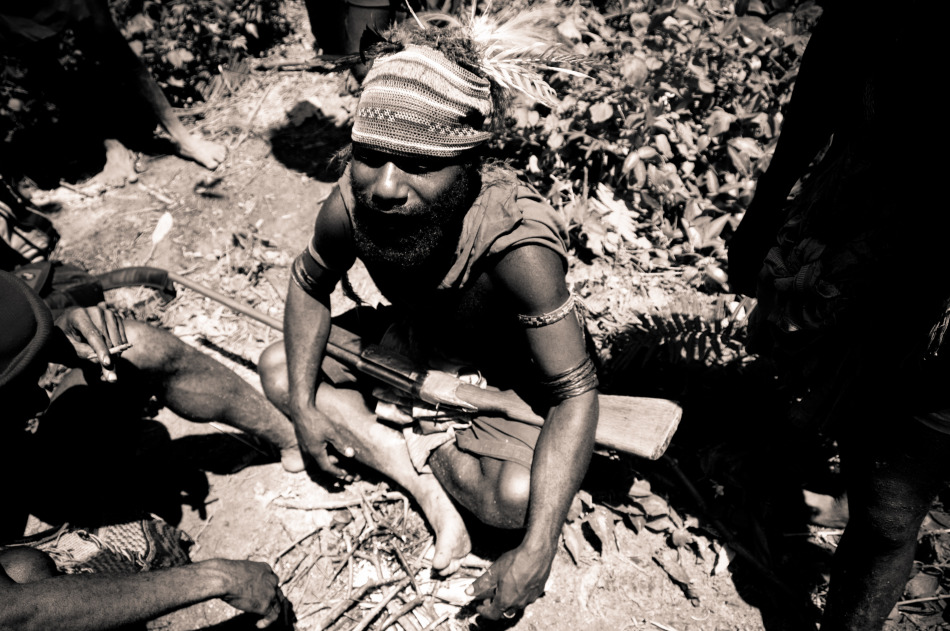PHOTO SERIES: FIGHT FOR YOUR RIGHT
The culture of tribal fighting has long been present in the Papua New Guinea highlands, a bizarre obsession in an area of such breathtaking landscapes. A simplistic mentality for revenge often drags out conflict for years and generations, as the logic of peace is overlooked in favour of instability.
Active conflict can present a rare opportunity to distinguish from the group, a chance to define personal character which is scarce in this shared community. After five years of travelling to Enga Province we witnessed how organised education could return stability to previously broken communities. The following photos were taken in the village of Yengis which was in the midst of a 15 year conflict, where the cycle of retribution killings had meant the town was completely abandoned and 15 tribes relocated into the surrounding hills. On my last trip to PNG in 2014 I was very fortunate to meet anthropology professor Polly Wiessner whose incredible research was published in science read the article here.
So why then would a group feel the need to maintain such a consistent brand of conflict? These are not people with violently incompatible religious beliefs, they are not separated by race, language, education or colour. Instead these are people who in many ways share a cultural identity, they face many of the same daily challenges and often share family ties and bonds. Although there are many factors, the most interesting to me is the idea that this shared identity actually feeds a need for conflict rather than reduces it. The conflict becomes a key factor in establishing rank, offering the ultimate arena to display valour and courage so highly regarded in highlands culture.
Members of the Komoti Tribe
Komoti has been one of the central tribes in the Yengis conflict which started in 2003 when Jack Nemo (a Komoti tribesman and president of the Yengis district) was shot dead whilst making a speech in the communal market place, triggering a chronic cycle of retribution.
Bokeah, Leader of the Komoti Warriors
Battles are fought by the young men typically aged 15-25 who are given the title of 'Warriors.' They live as nomads constantly patrolling the surrounding hills to protect their tribe and are given high standing once they return into the community after completing service.
The change from traditional weaponry
Although the fighting has existed for thousands of years, the introduction of modern weaponry in the 1990s had the initial effect of dramatically increased its severity. Hand-to-hand combat was been replaced by lethal gun fights as hand-made shotguns and automatic artillery become available for the cost of livestock, and occasionally as part of bride payments.
Growing up in the cross fire
One of the most alarming things about the conflict is how regular is feels to everyone in Yengis, particularly the children. They grow up surrounded by artillery, and in many ways eagerly await their chance to joining the conflict when they come of age.
Traditional fighting methods
Once the fighting 'officially' begins the conflicting tribes both relocate to more favourable ground, often digging tunnels under their huts to ensure a quick escape into the hillside if a tribe has breached. This traditional knowledge has been passed through generations of fighting experience.
Passing the time
For the young men on the front line of the conflict, the daily threat of violence brings an uneasy but constant tension to their days. Unsurprisingly smoking has become an addictive distraction with the bag of tobacco constantly being handed between the group, and rolled in a raw tobacco leaf to be smoked.
Wisdom in Age
Although the combat is generally carried out by much younger tribesman, the elders of the tribe still hold the role of key decision makers and tacticians. They instruct the warriors when they must attack and how, as well as organisation the remaining tribe in the face of retaliation attacks.
Trust in your mates
Despite the risks of their everyday lives these are still young (often adolescent) men and they will always find time for some banter and laughs. The bond they share it's undeniably tight given they must rely on each other for survival in these difficult years, as they transition into adulthood in tribal life.



















